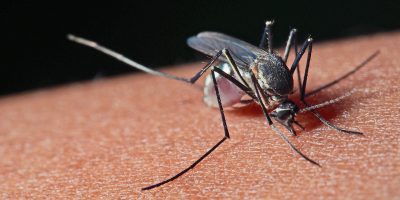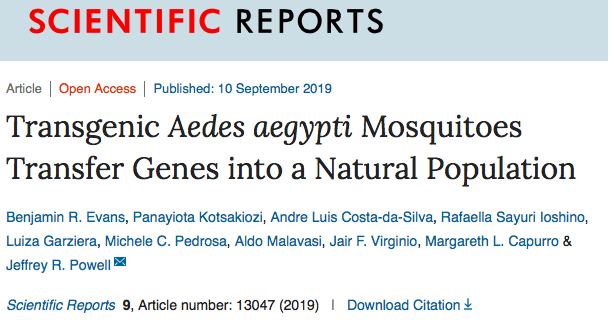Scientists Playing God Create Frankenstein Mosquito
Scientists Playing God Create Frankenstein Mosquito
Why
is an Oxitec-linked author leading an attack on her own paper? Report by Claire
Robinson and Jonathan Matthews
Global
Research, October 15, 2019
A
recent journal article about GM mosquitoes
has caused quite a stir. It showed that some of the
male mosquitoes that Oxitec Ltd released experimentally in Brazil had
successfully interbred with the local mosquito population, and that their
hybrid offspring were now spreading and propagating beyond the release area. This
despite Oxitec claiming its mosquitoes had a lethal gene that made them “self-limiting“.
The
paper came under immediate attack. No surprise there, you
might think, as many studies drawing attention to problems with GMOs have come under ferocious
attack following publication. Often this involves demands for retraction and
the deluging of journal editors with irate correspondence – campaigns of attack
for which there is good evidence of corporate
orchestration.
But
this time there’s a difference because the attacks by Oxitec, the company
behind the GM mosquitoes, have since been joined by one of the paper’s
co-authors, biochemist Margareth Capurro from the University of São
Paulo in Brazil.
So
who are the paper’s authors and why are they apparently at war with each other?
The study was conducted by a Yale University team led by population geneticist
Jeffrey Powell, who collaborated with Brazilian researchers to collect and
analyze DNA from mosquitoes before, during, and after the release of Oxitec’s
GM mosquitoes. Powell’s collaborators included Capurro and colleagues at the
University of São Paulo in Brazil, and these appear to be the authors demanding
the retraction.
It’s
worth mentioning though that these Brazilian co-authors are not as independent
of Oxitec as one might assume. Capurro and her colleagues had an agreement with Oxitec to monitor
the effects of the Brazilian release. Indeed, Capurro seems to have been
collaborating with Oxitec for years. She is the coordinator for the evaluation of
all the field releases of Oxitec GM mosquitoes in Brazil. And she has
co-authored papers with multiple
Oxitec affiliates.
It
is also worth noting that Capurro is the “principal investigator” for a
completely separate project, not involving Oxitec, to produce transgenic mosquitoes. A press release notes that the project
Capurro is leading “has already inspired the creation of several biofactories
to produce transgenic insects around the world.” In other words, Capurro’s
research centres almost entirely on projects that are completely dependent on
public acceptance of GM mosquito releases.
So
what are Capurro’s reasons for objecting to her own paper? Although she only
seems to have engaged with the journal Science about this through her lawyer, she has spoken
“exclusively” and in some detail about why she wants a retraction to the
Brazilian science publication Questão de
Ciência (A Question of Science).
Here
Capurro distances herself from the paper by placing the blame for its
contentious content entirely on the lead author, Jeffrey Powell, claiming “not
to have been part of – and least of all approved – the final version of the
manuscript”. This is somewhat surprising as the submission process normally
demands an assertion from the submitting author that all co-authors have seen
and approved the final manuscript.
Capurro’s
main complaint about the published paper is that there is nothing unexpected
about its results, even though the study shows that many offspring of the GM
mosquitoes survived and are spreading and propagating. According to the paper,
between 10-60 percent of the mosquitoes in the region concerned inherited parts
of the genome of the mosquitoes released in the trials. These findings are also
confirmed in neighbouring regions where no such trials were conducted.
Capurro
doesn’t dispute these findings but argues instead that “it was
already known that up to 4% of the males escaped the lethal gene and developed
into adults. Some degree of mating with the local population with healthy
offspring was completely anticipated and poses no surprise.” In other words,
nothing to see here – no reason for concern. This was all entirely to be
expected.
Except
this is not what Oxitec has been telling the world. Take for instance
this statement on their website explaining
“Our Science” and specifically their lethal gene: “The self-limiting gene is at
the heart of our method of insect control. When our male insects are released
and reproduce with wild females, *all* of their offspring inherit a copy of
this gene” (our emphasis).
Similarly,
as Christophe Boëte, who works on host-parasite interactions with a
particular focus on vector-borne diseases, has pointed out, even in the scientific
literature the Oxitec mosquito (OX513A) has been presented as “sterile”. He
gives the example of a paper by Lacroix et al,
which in its title describes the OX513A mosquito as a “Genetically Engineered
Sterile Male Aedes aegypti” and in its text describes it as “an engineered
‘genetically sterile’ (OX513A)” strain.
If
this is how Oxitec’s mosquitoes have been described in the scientific
literature, then it seems plausible that people living in the areas where these
field releases have been taking place have also been given the impression that
Oxitec’s mosquitoes are incapable of successfully reproducing.
And
there is clear evidence that this is indeed the case in a paper published in the
journal Emerging Infectious Diseases. It reports on the findings of a survey
into local residents’ “awareness and support” for the field release of Oxitec’s
OX513A mosquito in two places in Florida. The authors write that because these
male mosquitoes’ mating “results in death of offspring in the larval or pupal
stage of gestation… outreach activities in the area preceding the survey
referred to the mosquitoes as ‘sterile.’”
So
local residents were given the impression Oxitec’s GM mosquitoes could NOT
produce viable offspring. Indeed, because of this, the survey team themselves
included the word “sterile” in the survey that they did with local residents,
“because this term had been used in community awareness activities and should
have been familiar to those who had heard of the proposed release”.
If
this was the impression given to the communities in Florida, then there is
little reason to think that the communities in Brazil will have been provided
with more accurate information. We know this because after the Powell et al
paper was published, the views of a former Brazilian regulator who had written
a detailed report on the concerns the project raised were reported in the Brazilian
press.
In
his report Dr José Maria Gusman Ferraz had called on his fellow
regulators to suspend the release of Oxitec’s GM mosquitoes until further
health and environmental impact studies had been undertaken. And Dr Ferraz
specifically noted Oxitec’s failure to make clear the survival rate of their
mosquitoes, and the lack of studies on their mating with local mosquito
populations. He accused Oxitec of reducing local people to mere guinea pigs who
were neither properly informed nor meaningfully consulted about the risks
involved.
A film made in Burkina Faso about
the Target Malaria project also argues that the project does not have proper
consent from the affected communities for its experiment, and it includes
interviews with local people who say that they have not been properly informed.
These concerns around consultation and consent have also been raised by a group of 43 civil
society organisations from Africa and around the world.
The
issue of informed consent in relation to such projects is also raised in a
recent article by a group of experts
specifically interested in fostering public engagement on the environmental
release of genetically modified organisms intended to alter wild species. They
point to the “unknown risks” involved in GM mosquito releases and directly
accuse Oxitec of failing both to adequately assess and properly consult on
those risks:
“Given
that ‘around 5 per cent or less’ of the GM mosquito population was expected to
survive, shouldn’t Oxitec have made plans to assess the risk of gene transfer
to wild populations during their initial trials? And shouldn’t the Brazilian
government have required such an assessment as part of the regulatory approval
process, given their awareness of the risk?
“Instead,
with approval from Brazilian authorities, Oxitec released nearly half a million
GM mosquitoes every week into shared environments in Jacobina over a two-year
period from 2013 to 2015. This was done without the benefit of adequate risk
assessment and without proper public consultation.”
But
like Oxitec, Dr Capurro argues that neither the
survival nor the gene transfer are of any concern. They say the genes
transferred by the Oxitec mosquitoes to their surviving offspring are not
transgenic. They also claim that as OX513A mosquitoes are a laboratory strain,
their offspring will be less fit for survival in the wild, and both attack the
Powell et al paper’s claim that the offspring may instead have “hybrid vigour”
as mere speculation. But their claims about the impact of gene transfer to wild
populations are equally speculative. They’re based on assumptions, not
evidence.
Despite
this, Oxitec has filed a complaint about the
paper with the journal, Scientific Reports. On 17 September, the journal added
an editor’s note to the study, promising “a further editorial response” to
criticisms raised about the conclusions.
Powell
told Science magazine that he stands by the validity of the paper’s data and
analysis. He said the paper clearly states that the effects of DNA spread from
the Oxitec strain aren’t known and it raises some possible consequences without
claiming that they’ve been proven. And indeed, the wording of the paper does
seem to be far more cautious than Powell’s critics imply, e.g. “Thus, Jacobina
Ae. aegypti are now a mix of three populations. It is *unclear* how this *may*
affect disease transmission or affect other efforts to control these dangerous
vectors” (our emphases).
We
suspect that if the GM mosquito developers’ interests were not involved,
objections to Powell et al’s paper would have been far less strident. We are
particularly baffled by the extremity of the demands for retraction of the
paper, rather than the more proportionate and customary approach, which is to
request the journal to publish a correction or clarification. No one has
produced any evidence that the Powell paper meets any of the proper criteria
for the retraction of a study. These are unreliable findings
(involving misconduct or honest error), redundant publication, plagiarism, and
unethical research.
The
criteria for retraction do not include “failure to further qualify an already
qualified hypothetical statement” or “upsetting a GMO developer company and
those affiliated with it”. So if the paper does end up being retracted, someone
is going to have to come up with some creative reasoning as to why.
In
the meantime, the concerns are unlikely to go away about how adequately the
uncertainties around these GMO releases are being explored and disclosed, and
the extent to which those affected by these experimental releases are being
involved in the decision-making about them.
*
Note
to readers: please click the share buttons above or below. Forward this article
to your email lists. Crosspost on your blog site, internet forums. etc.
Featured
image is from GMWatch
The
original source of this article is GMWatch






/https://www.niagarafallsreview.ca/content/dam/thestar/news/canada/2021/09/25/huawei-executive-meng-wanzhou-receives-warm-welcome-upon-return-to-china/_1_meng_wanzhou_2.jpg)

No comments:
Post a Comment
Note: Only a member of this blog may post a comment.